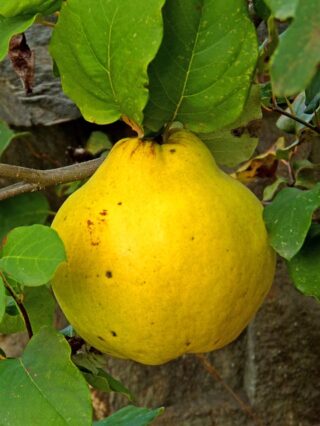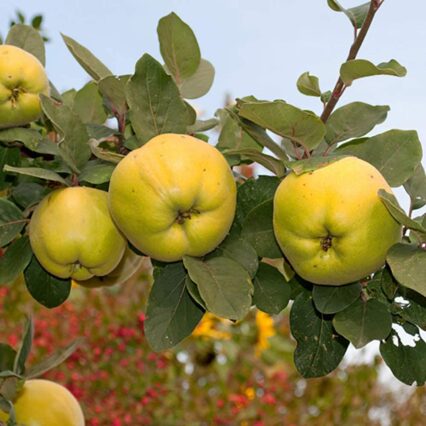Quince is a fruit that looks like an apple and pear combined. The fruit is good for making preserves as it has lots of naturally occurring pectin that makes jams and jellies set, though they are quite sour when eaten raw. The raw fruits do sweeten a little after a frost.

Quince trees are an excellent addition to any garden and with the right care and attention, they can thrive for many years. From providing a delicious harvest of fruit to improving the environment around you, there are so many benefits to growing quince trees. Here are just some of the reasons why you should consider planting one in your garden.
Benefits of Planting Quince Trees in your Garden
First off, quince trees produce a fantastic harvest of sweet and tangy fruit that can be used in cooking all year round. Whether you’re making preserves, jam or pies, the unique flavour of quince is sure to give your dishes an extra kick. Not only that, but you can also use quince in savoury dishes for a tart twist.
Secondly, growing quince trees offers a great way to increase biodiversity in your garden or outdoor space. Quinces provide a great habitat for wildlife such as birds, insects and small mammals due to their dense foliage which provides protection from predators and the elements. Additionally, quinces’ fragrant blooms attract pollinators like bees and butterflies which help to encourage other plants to grow.
Thirdly, growing quince trees can help improve air quality by absorbing harmful pollutants from the surrounding environment. This is due to their large leaves which act as natural filters for airborne toxins, making them incredibly beneficial for areas with high levels of pollution.
Overall, growing quince trees has many advantages which make them an ideal addition to any garden or outdoor space. From providing delicious fruit to improving air quality in your local area, these hardy plants offer so much potential for those looking to add some life and colour into their gardens. So why not give it a go?
Quince Rootstocks
Quince trees usually come as rootstocks, where the tree has been grafted onto the roots of another. This helps to determine the eventual size of the mature tree. The information should be available on the plant label.
Quince trees are either bush trees that are approximately 10-11ft in height, or half standards that grow to approximately 11-15ft.
Planting Quince Trees
Quince trees prefer a fertile, free draining but moist soil. A sunny position means that the tree will produce sweeter fruit as it ripens.
Plant quince trees in the dormant season, from November to early spring.
Caring for Quince Trees
Apply an organic fertiliser in spring time, but make sure that it is low in nitrogen. Nitrogen encourages lots of foliage growth, rather than fruit production.
A mulch applied during spring will help to keep the moisture in the soil and prevent weeds.
Pruning Quince Trees
To keep your quince tree in good health, it just requires a little pruning in winter. Cut back any branches that are damaged or growing too close together. This helps to keep an open structure to the tree. Old branches should not be cut back by more than a quarter. Quince trees are also suited to be trained into fan shapes.
Harvesting and Storing Quince
Quinces ripen in October and November. They are a hard fruit when ripe, but do get softer after a frost. When a quince is a golden yellow colour all over, it is ready to be picked.
Store in a cool place, and they will keep for a few weeks. The fruit is very fragrant, so keep away from anything that you don’t want to smell or taste of quince.

